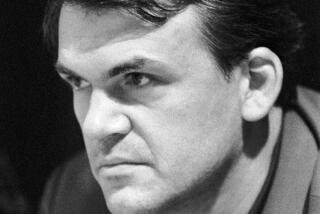Another rule to be broken
- Share via
In her essay “When to Bend, When to Break” (Book Review, Jan. 5), Ursula K. Le Guin nicely modifies John Rechy’s discussion of the “rules of writing” but, in doing so, creates her own constricting universal rule: “The characters of a novel and short story fascinate us slowly, deeply, by their passion, their pain, their moral and psychological complexity.” Well, yes, this is often true (as in, say, the novels of Toni Morrison and Anne Tyler), but it is not always true of good, even great, fiction. Consider, for example, Milan Kundera’s “The Book of Laughter and Forgetting,” a wondrously rich and strange novel that has no such characters. One might claim that, lacking such characters, it is either not a novel or not a good one, but that would be begging the question.
Mikhail Bakhtin claimed alternatively that the novel is not a genre, that it can include within its omnivorous self all genres. It is, as its name indicates, always the new, the disrupter of rules, affective as well as formal. Why reify our tastes into exclusive criteria, the sine qua non of novel and short story? Must a cat lover consider dogs to be God’s mistake because he is fascinated by the feline?
Le Guin’s examples of novels that don’t make the cut indicate further which characters need not apply. “Lolita,” it seems, is overrated because its characters are “jejune or shallow or callow.” Nonsense! Humbert the Hummer is one of the most imaginatively, emotionally, morally, verbally complex narrators in fiction, even if he does not fascinate Le Guin slowly, deeply. I have found few students, as well as critics, who were not quickly and deeply fascinated by Humbert; so apparently the “us” whose fascination determines novel and short story is not a collective singular. And what of poor Gregor Samsa, who cannot even qualify for Le Guin as a character because he is part of a fable and “[f]able has no characters.” Nonsense, again! Kafka’s stories are not simply fables, and Gregor is not the simple “cockroach” that Le Guin asserts. My 13-year-old, who was deeply moved by Gregor’s passion and pain, knew already that character is more a matter of consciousness than of phylum. My lad is literally jejune, but he can tell a character by daylight.
The moral of my lecture is that the house of fiction has many mansions, and there is no need to reduce it to a bungalow, even a well-designed Craftsman. As I have warned my fledgling literati, whose tastes are often, understandingly, limited, an elephant might make a lousy giraffe, but it is a marvelous creature in its own right. Together, they stretch the genre “mammal” and enlarge the mind.
David Eggenschwiler
Los Angeles
*
In her review of Christopher Ricks’ “Reviewery,” (Book Review, July 28), Wendy Lesser quotes Ricks, in regard to my 1985 biography of Robert Capa, as appalled that I could “brush aside the question of whether Capa’s most famous photograph, the falling soldier in Spain, was faked or not.” Neither then nor since have I ever brushed that question aside. In my book, I devoted several pages to the evidence and arguments pro and con. Conceding that we would probably never get the facts that would settle the controversy beyond doubt one way or the other, I stated that the greatness of that iconic image “ultimately lies in its symbolic implications, not in its literal accuracy as a report on the death of a particular man.” Nevertheless, I have continued my investigation of the picture’s accuracy since 1985. I was surprised and gratified when, in 1996, it was announced that a Spanish historian (who had himself fought in the battle at Cerro Muriano on Sept. 5, 1936, during which time Capa made the photograph) had convincingly identified the man in the image as Federico Borrell Garcia, who was indeed killed there that day. My reconstruction of the exact circumstances in which Capa made his photograph (in pursuit of which I even had a homicide detective give me a forensic reading of the image) was published in the spring 2002 issue of the photographic magazine Aperture. I hope that my article will end the pernicious allegations of fakery made against Capa and his great photograph.
Richard Whelan
New York
More to Read
Sign up for our Book Club newsletter
Get the latest news, events and more from the Los Angeles Times Book Club, and help us get L.A. reading and talking.
You may occasionally receive promotional content from the Los Angeles Times.









